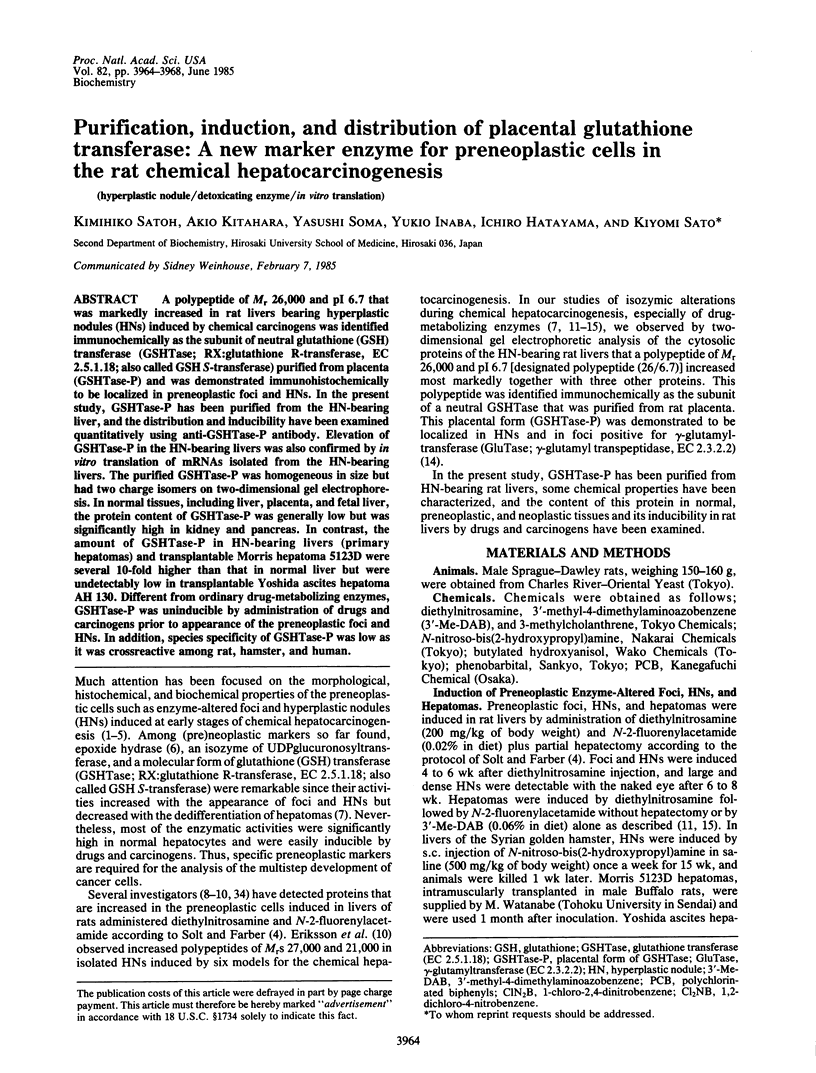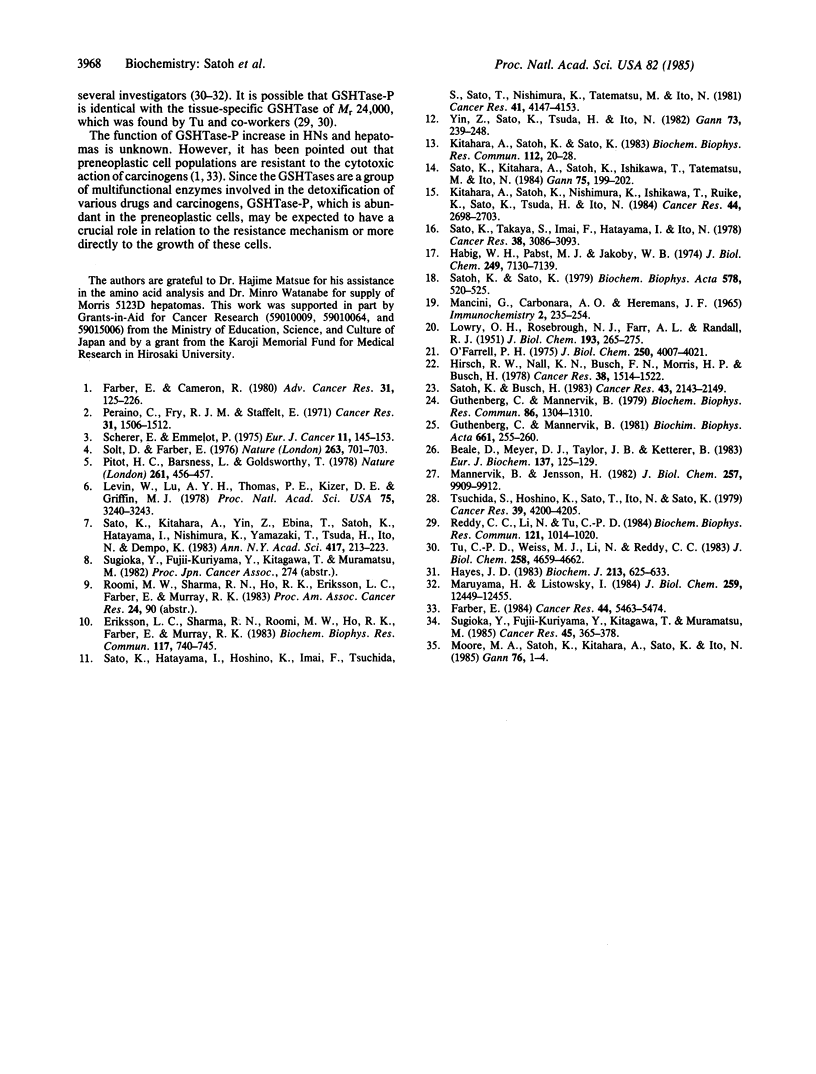Abstract
A polypeptide of Mr 26,000 and pI 6.7 that was markedly increased in rat livers bearing hyperplastic nodules (HNs) induced by chemical carcinogens was identified immunochemically as the subunit of neutral glutathione (GSH) transferase (GSHTase; RX:glutathione R-transferase, EC 2.5.1.18; also called GSH S-transferase) purified from placenta (GSHTase-P) and was demonstrated immunohistochemically to be localized in preneoplastic foci and HNs. In the present study, GSHTase-P has been purified from the HN-bearing liver, and the distribution and inducibility have been examined quantitatively using anti-GSHTase-P antibody. Elevation of GSHTase-P in the HN-bearing livers was also confirmed by in vitro translation of mRNAs isolated from the HN-bearing livers. The purified GSHTase-P was homogeneous in size but had two charge isomers on two-dimensional gel electrophoresis. In normal tissues, including liver, placenta, and fetal liver, the protein content of GSHTase-P was generally low but was significantly high in kidney and pancreas. In contrast, the amount of GSHTase-P in HN-bearing livers (primary hepatomas) and transplantable Morris hepatoma 5123D were several 10-fold higher than that in normal liver but were undetectably low in transplantable Yoshida ascites hepatoma AH 130. Different from ordinary drug-metabolizing enzymes, GSHTase-P was uninducible by administration of drugs and carcinogens prior to appearance of the preneoplastic foci and HNs. In addition, species specificity of GSHTase-P was low as it was crossreactive among rat, hamster, and human.
Full text
PDF




Images in this article
Selected References
These references are in PubMed. This may not be the complete list of references from this article.
- Beale D., Meyer D. J., Taylor J. B., Ketterer B. Evidence that the Yb subunits of hepatic glutathione transferases represent two different but related families of polypeptides. Eur J Biochem. 1983 Dec 1;137(1-2):125–129. doi: 10.1111/j.1432-1033.1983.tb07805.x. [DOI] [PubMed] [Google Scholar]
- Eriksson L. C., Sharma R. N., Roomi M. W., Ho R. K., Farber E., Murray R. K. A characteristic electrophoretic pattern of cytosolic polypeptides from hepatocyte nodules generated during liver carcinogenesis in several models. Biochem Biophys Res Commun. 1983 Dec 28;117(3):740–745. doi: 10.1016/0006-291x(83)91659-5. [DOI] [PubMed] [Google Scholar]
- Farber E., Cameron R. The sequential analysis of cancer development. Adv Cancer Res. 1980;31:125–226. doi: 10.1016/s0065-230x(08)60658-2. [DOI] [PubMed] [Google Scholar]
- Farber E. Cellular biochemistry of the stepwise development of cancer with chemicals: G. H. A. Clowes memorial lecture. Cancer Res. 1984 Dec;44(12 Pt 1):5463–5474. [PubMed] [Google Scholar]
- Guthenberg C., Mannervik B. Glutathione S-transferase (transferase pi) from human placenta is identical or closely related to glutathione S-transferase (transferase rho) from erythrocytes. Biochim Biophys Acta. 1981 Oct 13;661(2):255–260. doi: 10.1016/0005-2744(81)90012-7. [DOI] [PubMed] [Google Scholar]
- Guthenberg C., Mannervik B. Purification of glutathione S-transferases from rat lung by affinity chromatography. Evidence for an enzyme form absent in rat liver. Biochem Biophys Res Commun. 1979 Feb 28;86(4):1304–1310. doi: 10.1016/0006-291x(79)90258-4. [DOI] [PubMed] [Google Scholar]
- Habig W. H., Pabst M. J., Jakoby W. B. Glutathione S-transferases. The first enzymatic step in mercapturic acid formation. J Biol Chem. 1974 Nov 25;249(22):7130–7139. [PubMed] [Google Scholar]
- Hayes J. D. Rat liver glutathione S-transferases. A study of the structure of the basic YbYb-containing enzymes. Biochem J. 1983 Sep 1;213(3):625–633. doi: 10.1042/bj2130625. [DOI] [PMC free article] [PubMed] [Google Scholar]
- Hirsch F. W., Nall K. N., Busch F. N., Morris H. P., Busch H. Comparison of abundant cytosol proteins in rat liver, Novikoff hepatoma, and Morris hepatoma by two-dimensional gel electrophoresis. Cancer Res. 1978 Jun;38(6):1514–1522. [PubMed] [Google Scholar]
- Kitahara A., Satoh K., Nishimura K., Ishikawa T., Ruike K., Sato K., Tsuda H., Ito N. Changes in molecular forms of rat hepatic glutathione S-transferase during chemical hepatocarcinogenesis. Cancer Res. 1984 Jun;44(6):2698–2703. [PubMed] [Google Scholar]
- Kitahara A., Satoh K., Sato K. Properties of the increased glutathione S-transferase A form in rat preneoplastic hepatic lesions induced by chemical carcinogens. Biochem Biophys Res Commun. 1983 Apr 15;112(1):20–28. doi: 10.1016/0006-291x(83)91791-6. [DOI] [PubMed] [Google Scholar]
- LOWRY O. H., ROSEBROUGH N. J., FARR A. L., RANDALL R. J. Protein measurement with the Folin phenol reagent. J Biol Chem. 1951 Nov;193(1):265–275. [PubMed] [Google Scholar]
- Levin W., Lu A. Y., Thomas P. E., Ryan D., Kizer D. E., Griffin M. J. Identification of epoxide hydrase as the preneoplastic antigen in rat liver hyperplastic nodules. Proc Natl Acad Sci U S A. 1978 Jul;75(7):3240–3243. doi: 10.1073/pnas.75.7.3240. [DOI] [PMC free article] [PubMed] [Google Scholar]
- Mancini G., Carbonara A. O., Heremans J. F. Immunochemical quantitation of antigens by single radial immunodiffusion. Immunochemistry. 1965 Sep;2(3):235–254. doi: 10.1016/0019-2791(65)90004-2. [DOI] [PubMed] [Google Scholar]
- Mannervik B., Jensson H. Binary combinations of four protein subunits with different catalytic specificities explain the relationship between six basic glutathione S-transferases in rat liver cytosol. J Biol Chem. 1982 Sep 10;257(17):9909–9912. [PubMed] [Google Scholar]
- Maruyama H., Listowsky I. Preferential binding of steroids by anionic forms of rat glutathione S-transferase. J Biol Chem. 1984 Oct 25;259(20):12449–12455. [PubMed] [Google Scholar]
- Moore M. A., Satoh K., Kitahara A., Sato K., Ito N. A protein cross-reacting immunohistochemically with rat glutathione S-transferase placental form as a marker for preneoplasia in Syrian hamster pancreatic and hepatocarcinogenesis. Jpn J Cancer Res. 1985 Jan;76(1):1–4. [PubMed] [Google Scholar]
- O'Farrell P. H. High resolution two-dimensional electrophoresis of proteins. J Biol Chem. 1975 May 25;250(10):4007–4021. [PMC free article] [PubMed] [Google Scholar]
- Peraino C., Fry R. J., Staffeldt E. Reduction and enhancement by phenobarbital of hepatocarcinogenesis induced in the rat by 2-acetylaminofluorene. Cancer Res. 1971 Oct;31(10):1506–1512. [PubMed] [Google Scholar]
- Pitot H. C., Barsness L., Goldsworthy T., Kitagawa T. Biochemical characterisation of stages of hepatocarcinogenesis after a single dose of diethylnitrosamine. Nature. 1978 Feb 2;271(5644):456–458. doi: 10.1038/271456a0. [DOI] [PubMed] [Google Scholar]
- Reddy C. C., Li N., Tu C. P. Identification of a new glutathione S-transferase from rat liver cytosol. Biochem Biophys Res Commun. 1984 Jun 29;121(3):1014–1020. doi: 10.1016/0006-291x(84)90778-2. [DOI] [PubMed] [Google Scholar]
- Sato K., Hatayama I., Hoshino K., Imai F., Tsuchida S., Sato T., Nishimura K., Tatematsu M., Ito N. Enzyme deviation patterns in primary rat hepatomas induced by sequential administration of two chemically different carcinogens. Cancer Res. 1981 Oct;41(10):4147–4153. [PubMed] [Google Scholar]
- Sato K., Kitahara A., Satoh K., Ishikawa T., Tatematsu M., Ito N. The placental form of glutathione S-transferase as a new marker protein for preneoplasia in rat chemical hepatocarcinogenesis. Gan. 1984 Mar;75(3):199–202. [PubMed] [Google Scholar]
- Sato K., Kitahara A., Yin Z., Ebina T., Satoh K., Tsuda H., Ito N., Dempo K. Molecular forms of glutathione S-transferase and UDP-glucuronyltransferase as hepatic preneoplastic marker enzymes. Ann N Y Acad Sci. 1983;417:213–223. doi: 10.1111/j.1749-6632.1983.tb32865.x. [DOI] [PubMed] [Google Scholar]
- Sato K., Takaya S., Imai F., Hatayama I., Ito N. Different deviation patterns of carbohydrate-metabolizing enzymes in primary rat hepatomas induced by different chemical carcinogens. Cancer Res. 1978 Sep;38(9):3086–3093. [PubMed] [Google Scholar]
- Satoh K., Busch H. Characterization of nucleolar antigens of normal rat liver, regenerating rat liver, and Novikoff ascites hepatoma cells following in vitro translation of polyadenylic acid-containing messenger RNA. Cancer Res. 1983 May;43(5):2143–2149. [PubMed] [Google Scholar]
- Satoh K., Sato K. The high autoantibody activity of antibodies to rat skeletal muscle glycogen phosphorylase b produced in rabbits. Biochim Biophys Acta. 1979 Jun 19;578(2):520–525. doi: 10.1016/0005-2795(79)90182-x. [DOI] [PubMed] [Google Scholar]
- Scherer E., Emmelot P. Foci of altered liver cells induced by a single dose of diethylnitrosamine and partial hepatectomy: their contribution to hepatocarcinogenesis in the rat. Eur J Cancer. 1975 Mar;11(3):145–154. doi: 10.1016/0014-2964(75)90109-7. [DOI] [PubMed] [Google Scholar]
- Sugioka Y., Fujii-Kuriyama Y., Kitagawa T., Muramatsu M. Changes in polypeptide pattern of rat liver cells during chemical hepatocarcinogenesis. Cancer Res. 1985 Jan;45(1):365–378. [PubMed] [Google Scholar]
- Tsuchida S., Hoshino K., Sato T., Ito N., Sato K. Purification of gamma-glutamyltransferases from rat hepatomas and hyperplastic hepatic nodules, and comparison with the enzyme from rat kidney. Cancer Res. 1979 Oct;39(10):4200–4205. [PubMed] [Google Scholar]
- Tu C. P., Weiss M. J., Li N. Q., Reddy C. C. Tissue-specific expression of the rat glutathione S-transferases. J Biol Chem. 1983 Apr 25;258(8):4659–4662. [PubMed] [Google Scholar]
- Yin Z., Sato K., Tsuda H., Ito N. Changes in activities of uridine diphosphate-glucuronyltransferases during chemical hepatocarcinogenesis. Gan. 1982 Apr;73(2):239–248. [PubMed] [Google Scholar]




